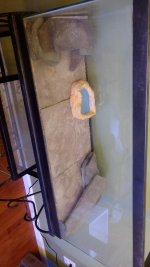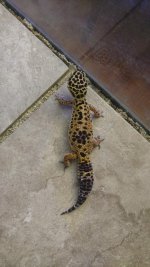Hello everyone, new to the forum and to leopard gecko's. Was not actually expecting to get a gecko, so here is the story. I am a big fish fan, I currently have set up a 210 gallon saltwater reef. I always have put out on Craigslist accepting any unwanted tanks. Well yesterday I was contacted by a lady who asked if I would pick up a couple tanks from her as well as her leopard gecko, she said if it didn't get picked up she was releasing it into the wonderful Ohio woods. So naturally I picked it up. It looks healthy, being housed in a 15 gallon tank with one hide, food bowl, water bowl, a reptimat and the only source of heat being an undertank heat mat. I have a couple of old 30 Gallon tanks so it will be getting an upgrade in size, as well as I plan to go buy some slate for a substrate and add a couple more hides and some lighting. I have never cared for a leopard before so this is all new to me. My experience is fish and tortoises, now my wife has experience with bearded dragons but that has been a while ago. As for a name we are debating between mhmm or scratch, as out 8 month old daughter either looks at it and says mhmm or scratches at the glass. Any advice would be great and if I'm doing something horribly wrong please yell at me.
Thanks,
Tyler
Thanks,
Tyler




